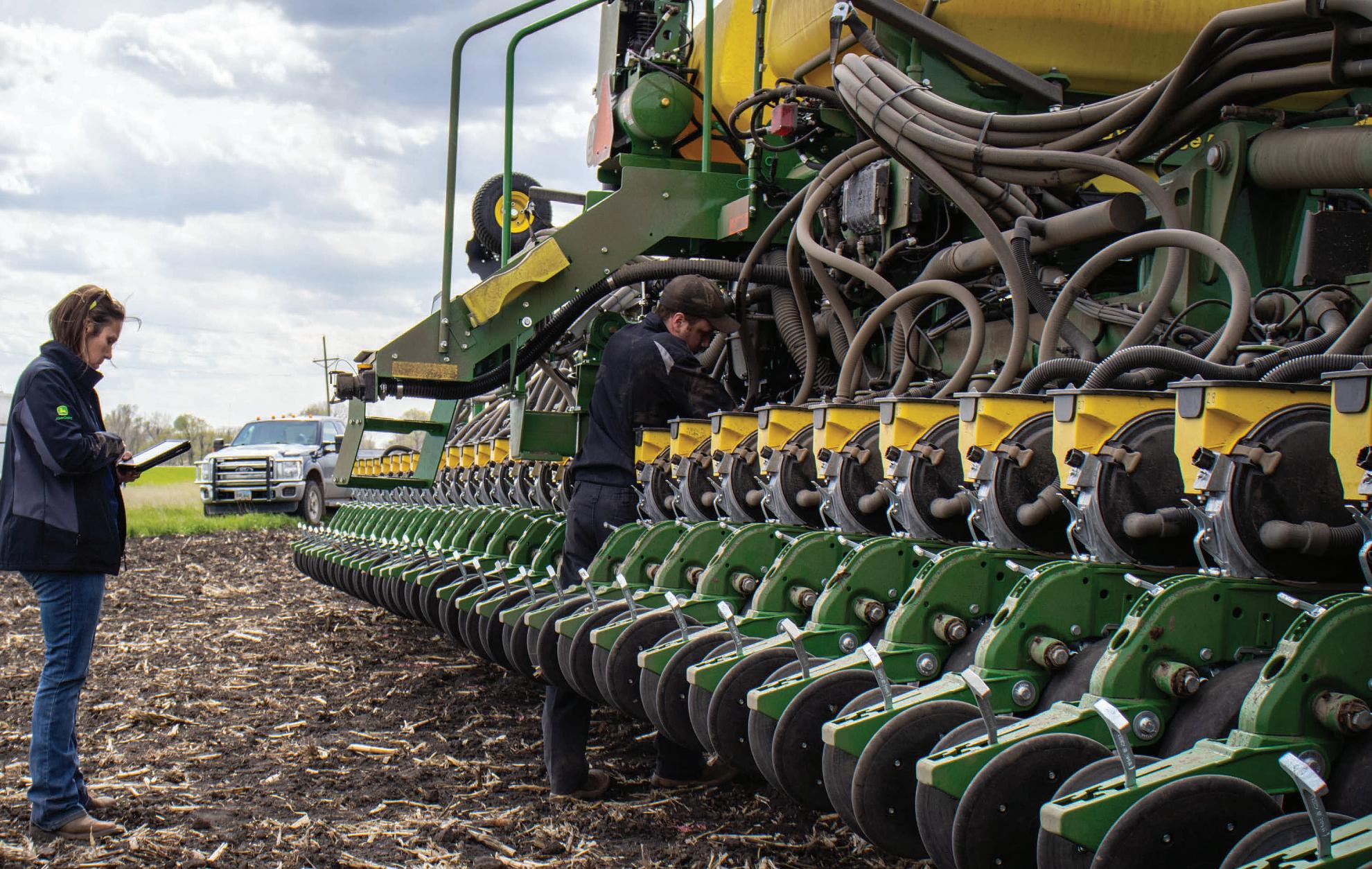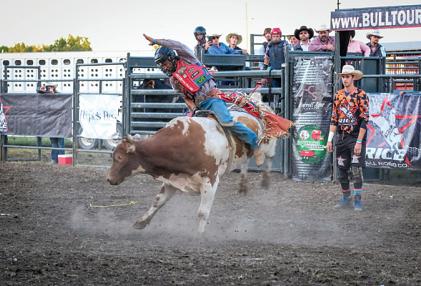

























Classrooms and communities across the country will recognize the 50th anniversary of National Agriculture Day (Ag Day) on March 21, 2023. Ag Day is an opportunity to celebrate the contribution of agriculture in our everyday lives.


As this milestone approaches, Brian Buhr, dean of the College of Food, Agricultural and Natural Resource Sciences, reflects on the last 50 years in the industry and answers questions about what we expect the next 50 years to look like.






When you think about the last 50 years in agriculture, what do you consider to be the biggest strides and successes?



Dean Buhr: Throughout the last five decades, agricultural technology has been continuously and dramatically improved and modernized. Increases in both efficiency and sustainability have abounded in everything from machinery and inputs to plant genetics and new crop varieties. Tractors and combines have grown bigger and faster; fertilizers are better; plant breeding innovation has brought crops that are more resilient, resist pests and use fewer resources; soil testing has advanced; we have GPS and drone technology; and much more. As a result, farmers today produce more food on less land using less nutrient inputs. These advances are significant to our work to protect the planet for generations to come, as we continue to focus our scientific efforts and research on climate adaptation and mitigation.
Continued on page 4


Continued from page 3
How will Minnesota play a role in agriculture’s future?

Dean Buhr: For generations, agriculture and food systems have been at the heart of Minnesota, fueling our state’s economy and providing nourishment worldwide. Today, we have the distinct opportunity to make Minnesota the global leader in advancing food and agriculture research, education and outreach. As part of a public-private partnership and in collaboration with Riverland Community College in Austin, we’re exploring the development of an integrated advanced agricultural research complex in Mower County known as the Future of Advanced Agricultural Research in Minnesota (FAARM). This will be a first-of-itskind complex that serves as a catalyst for research, innovation and economic development. It will offer integrated innovation, instruction and visionary technology that fuel the growth of rural economies while working to solve the world’s grand challenges, including adapting to and mitigating climate change.
Is there any particular technology that you think is poised to make a significant impact on agriculture?

Dean Buhr: Over the centuries, advances in agriculture have moved from mechanical (using machines to do the work), to chemical (such as applying pesticides and herbicides), to biological (the Green Revolution), to current major breakthroughs with digital data. This is a huge step in the natural evolution of agriculture, and it is happening at the U of M in a big way with our agri-food informatics initiative. It works with agricultural data from farm entities big and small, curating it, making it interoperable (able to talk to each other) and analyzing it both short and long term. This makes it possible to create research-ready agri-food data and turn it into actionable information, which is game-changing in addressing the many issues facing local and global agrifood systems today, from climate change and pests to diseases and markets. We’ve also seen major advances in the computational and data capabilities that allow us to measure and understand the billions of molecular interactions that affect the health of the only biome we have — Earth! This
includes advanced genetics; understanding the microbiomes from soil that impact soil fertility and plant health; and understanding the microbiomes of human and animal digestion that impact digestion and health. As we look to the future, we will continue to improve and refine the technology that provides data that has been so groundbreaking for agriculture, such as artificial intelligence, satellites, sensors, drones, facial recognition and much more.
As you look ahead to the next 50 years, what do you think will be the biggest challenges for the industry?

Dean Buhr: We will continue to be challenged with finding new, more and better ways to sustainably feed our world’s growing population while providing successful livelihoods for farmers and protecting our environment. To do this, it is imperative that we invest in agricultural research and development (R&D). Agricultural innovations are a formidable challenge, and there are often gaps of a decade or more between investment in ag R&D and having new crop technologies available to farmers. Currently the need for ag R&D investment is much greater than the supply. A recent report from the Supporters of Agricultural Research Foundation found that research investment generated returns of 10 times the amount invested over the past 50-some years. This means that on average, a dollar invested today brings a future return equivalent to $10 in present day value. We must prioritize investment in ag R&D.
How is the College of Food, Agricultural and Natural Resource Sciences preparing students to take on the world’s future challenges with innovation and responsibility?
Dean Buhr: Our aim is to prepare students for their first job and for the job they’ll have 20 years from now, many of which don’t even exist yet. They arrive here eager to make a positive impact in the world. With 27 programs in disciplines involving food, agricultural, and natural resource sciences, CFANS provides interdisciplinary, hands-on learning experiences that foster their curiosity and creative thinking. Our faculty inspire students to find solutions to global challenges, such as feeding a rapidly growing population while conserving and protecting our natural resources for generations to come. n
Shifting consumer demands pose a challenge for any industry, including the agricultural sector. Farmers who want to ensure they’re in the best position to meet consumer demands in the coming decades may be happy to learn that an aging population figures to work in the agricultural sector’s favor. The Economic Research Service with the U.S. Department of Agriculture notes that individuals over age 65 are expected to make up a greater percentage of the overall population in the years to come. That should, the ERS notes, benefit farmers, as older individuals tend to be more health-conscious with their eating habits than younger generations. The same trend will likely play out in Canada, where Statistics Canada estimates the percentage of individuals age 65 and older will increase to 22.5 by 2030, marking a nearly 10 percent increase since 2010, when just 14.1 percent of Canadians were 65 or older.

Farmers, if you’re thinking about your plans for the upcoming growing season, join University of Minnesota

Exten-


sion for County Crops Day, where we will discuss crop management tactics and share research updates. There are lots of places you can get your information, and U of M Extension delivers research-based information to help you make decisions that benefit your farming operation and your bottom line.
Join Extension researchers for the latest updates in crop management on March 7, at 10:00 am — 2:00 pm at the Rice County




4-H building in Faribault.
Dr. Dean Malvick, U of M Extension plant Pathologist, will discuss crop disease management, highlighting corn tar spot and white mold, which are both present in this region of Minnesota. Since tar spot was first found in Minnesota in Fall 2019, the disease has been spreading in Minnesota and nearby states. Corn fields in southern Minnesota should be scouted throughout the growing season. Though corn tar spot hasn’t caused significant yield losses in Rice and Steele counties, it can cause significant yield loss under the right conditions. Multiple different fungicides applied at growth stages VT-R2 have been shown to be effective for reducing tar spot, and corn hybrids also vary in susceptibility.
U of M Extension corn agronomist, Dr. Jeff Coulter, will provide research updates on integrating mid-season application of nitrogen and sulfur into corn production. The results of this study will likely be of interest to corn producers. Additional nitrogen-related education will be presented in the upper mezzanine
at the North American Farm and Power show in the afternoon of Friday, March 17.
Extension crops educator, Ryan Miller, will provide updates in weed management, covering research trials from the Rochester Extension regional office. Weeds take the top spot as the most problematic pest problem farmers manage, and Ryan will discuss management tactics as well as research results.
Pamela Stahlke Director of the USDA Risk Management Agency’s (RMA) St. Paul Regional Office, will talk about how to make the most of your crop insurance in 2023. Pamela will discuss a brief overview of the crop insurance delivery system, what’s new in crop insurance for 2023, and how to take advantage of existing crop insurance options to maximize risk management in today’s farming economy. Topics of discussion will include the double cropping soybean expansion, availability of Revenue Protection for oats and rye, and updates on livestock insurance products.
A few other hot topics will be discussed, including updates
on soybean gall midge, which is an emerging pest of soybean. Though soybean gall midge has mostly been present in the western part of the state, it was found in Rice County in the 2021 growing season. Research about the soybean gall midge’s biology is ongoing, and researchers are

exploring management tactics. Again, join us for this free event on March 7 in the Rice County 4-H building, 1900 Fairgrounds Drive, #17, Faribault, MN 55021. Lunch will be provided, thanks to partnership with KDHL and KRFO radio. n

REGIONAL MANAGING EDITOR:
PHILIP WEYHE
SALES DIRECTORS:
TOM KELLING & ROSS ULRICH
ADVERTISING:
DEANNA BOLAND, AMBER CASTERTON, KATHLEEN DAVIES, STEVE HADRITS, CRYSTAL HOBART, TIM MART, VICTORIA RUD
All advertising contained herein is the responsibility of the advertisers. This publication is ©2023 by APG SoMinn and no content can be reproduced without permission. SoMN Spring Ag is delivered to all subscribers of Owatonna People’s Press, Faribault Daily News, North eld News, Kenyon Leader, Waseca County News, Le Sueur County News and St. Peter Herald at no cost.

 By DAN GUNDERSON Minnesota Public Radio News
By DAN GUNDERSON Minnesota Public Radio News






Farmers markets and local food networks aren’t new to Minnesota. But the movement gained momentum during the pandemic — and a partnership of more than 40 organizations hopes to capitalize on that grassroots growth.

“The local food movement coming out of the pandemic took root. There is a lot of movement in this now,” said Kathy Zeman executive director of the Minnesota Farmers Market Association. “We’ve just reached 362 farmers markets. It’s the highest number of farmers markets we’ve ever recorded in the state of Minnesota.”
There has also been growth in online connections

between farmers and consumers.
Sazzy Calhoun works in the film industry, so she was sidelined when COVID-19 shut down film production.
In May of 2020, from her home in the north metro, she decided to start a Facebook group with the goal of connecting farmers and consumers.
“I started it just because of the need that I was seeing out in the world during COVID-19. I remember I sat there with my finger on the [keyboard] button, and I thought, ‘Is this really silly? Am I going to be a group of one person?’”
But in a case of right place, right time, Farm Direct Minnesota took off and it’s still growing nearly three years later. The group has about 75,000 members and still attracts about 900 new members a month.

“I think there is going to be sustainability as long as people want fresh food and see the value in that, and I don’t think they’re going to stop seeing that value,” said Calhoun.
Christina Traeger was among the first farmers to join the Farm Direct Facebook group, offering a quarter or a half side of beef for sale.
“It brought us a connection, together with people who needed that quarter or half because their freezer was empty,” she recalled.
Traeger had been selling directly to
consumers for about a decade from her farm near Avon, Minn. She used her own Facebook page and a website to sell beef, pork, lamb and poultry.
The new Facebook group expanded her marketing reach, but also brought marketing challenges.
“You get the people who will come on there and say, ‘Well, I can get this for $3.99 at Walmart,’” she said of the occasional online trolls.
“We take a lot of pride in what we produce as farmers. If somebody is saying things that are not very polite, you know you kind of get feeling bad, going ‘What did I do wrong?’” she said.
“But on the flip side you get 20 people who are just super tickled. They saw my post on Farm Direct and they came to the market and came to the farm and picked stuff up and messaged me the next day and said that was the best meat they’ve ever had.”
Traeger believes direct marketing is the future for her farm even though the challenges of running a farm and a direct marketing business can be overwhelming at times.

In the future, she and other small farmers might get more support.
A new initiative funded by a federal grant and led by the Minnesota Department of Agriculture and the University of Minnesota is taking a deeper look at the needs of small farmers and local food systems with
the intention of creating a strategic plan for supporting local food systems.

“We’ve never collected data like this before, we’re already really excited to be learning from it,” said regional marketing specialist Kate Seybold.
For the past two years, the state ag department has been building relationships with small farmers and BIPOC communities to gather data and ideas about local food networks.
They’ve learned that many small farmers are not participating in the federal USDA Census of Agriculture, the benchmark for data about agriculture. That leaves a void in knowledge about local food production and networks.
“This data is really helpful to have, both from the producer side but then also our supply chain partners and consumer side,” said Seybold. “We’ll be using to kind of inform what that strategic action plan looks like.”
While the agency is still developing specific action steps from the data, Seybold says it’s clear there is enough interest and economic benefit to support a more strategic approach to local food systems in the state.
The work so far is exposing challenges.
“One of the things that really stands out is people see this type of work in many, many different places, a lot of people are involved in it, it’s just that it’s like we’re all siloed,” said University of Minnesota professor Hikaru Peterson.
“Even just to put this statewide cooperative partnership work forward, we realized that ‘Oh, there’s somebody else who’s kind of doing something similar,’ and you really have to collaborate.”
The research also pointed out that many
BIPOC groups don’t trust institutions like the Department of Agriculture. So the group invested a lot of time in building relationships, said Seybold, and that effort needs to be ongoing.
Better data collection is also a critical need according to Peterson.
“There’s just a lack of market transparency because of the lack of data infrastructure.”

While commodity agriculture — corn and soybeans — has decades of data around production and market prices, the same data infrastructure does not exist for local food producers.
“And if there’s a way of providing like a real-time market data in local and regional markets that these small and medium size farmers can use, I think it can really benefit and strengthen the support as well,” said Peterson.
Another apparent area of agreement is the need for more investment in infrastructure such as community commercial kitchens for safe food production, community cold storage and community food hubs. Those all require capital investments small farmers often can’t access, but are needed to support the connection between farmer and consumer.
“And it doesn’t matter whether you’re in a sparsely populated township in the county in Greater Minnesota, or you are in a densely populated part of the Twin Cities where there’s like one grocery store left,” said Zeman.
State investment in that infrastructure is likely to be one of the recommendations when the final report on supporting local and regional food markets is completed later this year. n
“The local food movement coming out of the pandemic took root. There is a lot of movement in this now.”
- Kathy Zeman executive director of the Minnesota Farmers Market Association.By COLTON KEMP colton.kemp@apgsomn.com






One of the most important aspects for attracting wildlife is “replicating nature,” according to River Bend Nature Center Naturalist Matt Johnson. Johnson explained this and more at River Bend on Saturday afternoon, during what would’ve been a presentation about attracting wildlife. However, since no one registered for the


event, it was cancelled.

Instead he sat down with the Daily News to outline some key advice for people looking to attract wildlife to their yard.

“Really (we’re) just trying to get people to plant more natives,” he said. “You know, they’re designed to grow here. They’re adapted to the climate too. All the pollinators need them. So, we try to mimic nature. That really (attracts) the most wildlife.”
One thing Johnson pointed out is that “not all nonnative plants are bad.”
“There’s a lot that can live in your garden and it’s fine,” he said. “If you think about annuals — plants that don’t come back the next year — they don’t pose any threat. There’s a lot of others if you look online. A lot of the times, they’ll have good lists of plants that are not going to get out of your garden and into nature.”
However, many of the nonnative plants that were introduced to beautify gardens, wound up becoming invasive species in the local environment. One of those nonnatives is a purple wildflower called dame’s rocket.
“That was brought over as a garden flower, and it’s a very pretty flower,” he said. “But if you ever come back, usually sometime late May, early June, it’s just kind of everywhere. It can outcompete native species. So, it’s become a thing we’re trying to tackle.
“Buckthorn is another one that was brought over. It’s kind of like a shrub, a hedge. That’s really taken off and really affected the natural ecosystem, here in the forests.”
Another big thing for attracting several kinds of wildlife is implementing a water source. Even something as simple as a birdbath can have an impact.
“It’s kind of funny,” Johnson said. “I have a birdbath and it kind of attaches to my deck. And tree frogs will actually hide underneath it during the day, because they usually more come out in the evening at night. … During the evening, they can just go right up on top. So, they’ll get right out and then they hunt.”
Native berries and cherries attract birds and other wildlife. Anything that provides food, like fruit, is good for wildlife, Johnson said.
For bird feeders, Johnson said it’s important to put stickers or something on the glass, so birds don’t fly into the glass and injure themselves.


Squirrels and deer can ruin the experience of bird feeders, Johnson noted. Keeping them out of reach for deer is vital to not having the feeder destroyed.
Squirrels are a bit more persistent and


can “empty the feeder” in one sitting. Having a substance called suet is able to mitigate that issue. Suet is a mix of various foods that can be kept in a small cage, preventing squirrels from accessing it while still allowing birds to peck away.

When it comes to having a healthy garden and being environmentally aware of the impact a garden has, Johnson said accommodating pollinators is important. Bees and butterflies, especially monarchs, are at risk of extinction.
Native flowers, milkweed and butterfly weed are good for attracting pollinators.
“Milkweeds are what they eat when they’re caterpillars, and so it’s kind of that larval food for them,” Johnson said. “It’s really the only thing they eat. So, if we didn’t have any milkweed, we would not have any monarch butterflies. That’s why you’ve seen like a big decline in monarch populations.
He attributed the decline to farming and ditch mowing and “just the clearing of a lot of those native prairies.” n






While local residents are preparing for another heavy snowfall this week, agriculture students at Cleveland Public Schools have been keeping their plants and seedlings safe from the winter frost inside the district’s new greenhouse.
The 24-by-48-foot greenhouse was opened up to students starting this fall semester, allowing kids to plant, grow, sell and cook their own herbs and vegetables directly on the Cleveland campus.
With the spring semester in full swing, a new batch of high school students in Cleveland’s Horticulture and Intro to Agriculture classes have been busy setting up the facility for a new season and planting seeds for a spring harvest.



Freshmen in the Intro to Agriculture class will soon be planting herbs like cilantro, oregano and parsley in hydroponic units which provide nutrition to greens through a water-based solution rather than soil. Once the herbs are fully grown, the spices will be distributed to cafeteria staff for use in school lunches.
Cleveland Agriculture instructor Kelly Susa noted the program gives students hands-on experience in managing plants from seed to harvest and finally the kitchen table.

“It’s a full-circle kind of system,” said Susa. “I know the Horticulture class, they did research on which varieties of flowers and vegetables and things to sell, they priced out seeds from different retailers and got those purchased. Now they’re planting them and making sure they don’t kill them between now and our plant sale.”
The greenhouse not only allows students to comfortably grow plants during cooler times of year, it also grants students the opportunity to ex-

periment with different horticultural techniques. In Rebeca Herberg’s Horticulture class, students have been planting vegetables in soil based units while Intro to Ag works with hydroponics.
The greenhouse also features several vertical aeroponic units, also known as tower gardens, in which plants are suspended in air and cultivated with a liquid nutrient solution. Students are currently planting seeds in a soilless, mineral
base called rockwool. Once the crops have sprouted into seedlings, they’re ready to be moved to the tower gardens for the rest of the growing period.


Last semester, the agriculture classes put these horticultural techniques to the test. The classes ran an experiment to track whether soil-grown plants or hydroponicallygrown plants would consume the most resources like water and nutrients.
“The students got really invested in that, finding out which is better and if hydroponics are the way of the future or for leafy greens,” said Susa. “Our results were inconclusive, we had to work out some kinks with our study, but being able to do comparisons like that and different projects was great.”
Susa aims to utilize the greenhouse for future student experiments.






















The facility additionally serves as a resource for students in Cleveland’s Future Farmers of America’s program to grow crops, flowers and run trials and research.












The greenhouse’s debut this school year was made possible by an $87,000 grant from the Future Ready CTE program by the South Central Service Cooperative. Susa acquired the grant in 2021, which financed the costs of the greenhouse kit and construction. n





Is rye a cost-effective diet for pigs? Do cover crops live up to the hype? What small grain varieties are best suited for southern Minnesota?
Educators with the University of Minnesota Extension Office discussed these questions and more with a crowd of around 20 farmers at the Le Sueur County Fairgrounds in Le Center Tuesday.
Diane DeWitte, a swine educator with the Extension Office, opened the small grain update by diving into recent research on how a rye diet impacts organic hog production. Researchers aimed to see if rye could work as a cost effective replacement for corn and lower the costs of raising livestock.
The results so far have been promising. In 2021, researchers at the U of M Morris developed 17 acres of a hardy, high-yielding hybrid winter rye variety called KWS Tayo. The rye was used both as a source of feed for the swine and as bedding.
With 800,000 seeds planted per acre, the yield averaged 104 bushels to the acre and 1.8 tons of straw per acre.
Researchers then compared pigs on a corn and soybean diet to 100 pigs raised with a half corn, half winter rye diet and found no statistical differences in the growth of the pigs. DeWitte noted that hybrid rye provides 92% of the energy of corn. While not as good as wheat, the rye
served as an effective substitute for corn and provided more energy than barley and oats.
The combined savings of using the rye for feed and bedding was estimated at approximately $738 per acre, but DeWitte cautioned that total may be higher than what one would normally expect.
“It seems a little high, and there are some reasons for that. One is that the yield was pretty darn good. Some years, they’ve only had 43 bushels to the acre, and you wouldn’t see that kind of savings if you didn’t have 100 bushels to the acre,” said DeWitte.
At the time of the experiment, corn prices were also approximately $4 more than rye per bushel, contributing to the large cost savings. U of M researchers are continuing with a second trial this year to collect more data.
A second phase of research aims to test pork quality of pigs raised on rye with blind taste-testing trials.

“We’re just halfway through the project,” said DeWitte. “Some of the points to take home would be putting hybrid rye into your crop rotation, it would have to be a substitution for another small grain, but it can have some weed control effects and the long-term yield could be good.”
Across the United States and in Minnesota, an increasing number of farmers have adopted cover crops like oats and rye into
their rotations as conservation agencies and advocates have promoted the crops as an important tool for preventing erosion and storing water, reducing nitrate contamination and maintaining soil fertility.
But U of M Small Grain Specialist Jochum Wiersma warned attendees that the productivity benefits of cover crops to farmers aren’t as lucrative as they are often advertised to be.
“The major question really is, are we really losing productivity? Look at the average state yields for corn, we’re still going up — pretty substantially actually. That’s not all genetics, I don’t care what the breeders say,” said Wiersma.
As a nitrate reducing agent, Wiersma suggested cover crops have a limited impact when put into a corn and soybean rotation. Wiersma cited a 2006 study in the
Agronomy Journal showcasing the potential of fall rye to reduce nitrate run-off in Southeastern Minnesota. At its peak, the study found rye planted on Sept. 15 could cut nitrogen loss by 40% on May 30.
But Wiersma said cover crops are often terminated well before their maximum potential in late May and June so that corn can be planted in early May without any vegetative competition to get a higher yield.
“The vegetative growth after soybeans and corn, it doesn’t take up enough nitrogen to make a difference, 15 pounds maybe,” said Wiersma. “The termination of your cover crop too early, before the potential of leaching is the greatest May through June, you are eliminating that cover crop.”
By April 30, the potential nitrate loss attributable to rye is closer to 30% and below 20% if terminated by the end of March, according to the study. That assumes the rye is planted by Sept. 15, but Wiersma noted if the crop is planted too early, it’s susceptible to pests like the Hessian fly and armyworms.
Hessian flies are known to lay their eggs in vegetation in the fall, which then develop into larvae in the summer and feed on grain stems. In recent growing seasons, the pest has increased its presence in Minnesota as the adoption of crops like winter rye and barley have given them places to nest.
Rye can also serve as a host for armyworms and their offspring. Corn planted into a rye cover crop are the most susceptible, but the larvae are known to eat soybeans as well if they are hungry enough, Wiersma noted.
“To me, rye as a means to reduce nitrate leaching is kind of like a band-aid on an arterial bleed, because you are terminating the rye too early to really make a difference,” said Wiersma.

One of the other agricultural benefits of cover crops is their capacity to increase soil infiltration, allowing fields to dry faster after heavy rains and flooding. But Wiersma advised that their utility in managing water is mixed when a growing season with too much moisture can be followed by a drought the next year.
“As a way of managing soil moisture, I think cover crops are a crapshoot because weather is unpredictable,” said Wiersma.
When considering cover crops, Wiersma advised that farmers should evaluate them as any other crop.
“Rather than thinking about cover crops, why don’t we just think of it as a crop and just widen our rotation?” said Wiersma. “If we want to go down this path and make
this part of our system, we still have to adhere to all the old principles. We cannot beat Mother Nature, she’s going to beat you if we ignore all those things that we already know.” n
Farming has never been a vocation for individuals looking for easy work. Farmers typically work long hours, braving the elements regardless of how unpleasant the weather may be.

All that hard work ensures individuals who live in rural, urban and suburban communities have constant, readily available access to healthy foods. Such devotion merits support, and thankfully there are many things consumers can do to show their appreciation for local farmers.
· Buy fresh foods at your local farmers


market. Farmers markets are many foodies’ favorite places, but they aren’t exclusive to individuals with a passion for food. Everyone needs to eat, so why not eat foods grown locally, which are generally more fresh and appetizing than imported fruits and vegetables sold at chain grocery stores? Even individuals who don’t typically eat
fresh fruit and vegetables can find something delectable at a local farmers market, where anything from homemade tomato sauces to locally raised fresh beef and pork might be on sale.
· Order directly from local farms. Some farmers have embraced the e-commerce revolution and begun selling the foods they grow to consumers via their own websites. Research local farms and determine if it’s possible to buy directly from them. Farms may offer delivery or pick-up, and consumers can enjoy fresh foods even more knowing that they helped farmers earn higher profits by buying directly from them.
· Check labels before buying in local grocery stores. Packaging labels will indicate where fruits and vegetables came from. When possible, choose items produced by local farmers. This may include fruits, vegetables, meat, pork, or even desserts like pies. Locally produced foods often taste more fresh than items sent from overseas or distant farms, and consumers will feel better knowing they helped to support local farmers.
· Spread the word. Get the word out after a satisfying experience with local farms and farmers. Whether it’s buying food from farms or taking advantage of family days that let kids enjoy a day on the farm, sharing positive experiences via social media or word-of-mouth can be a great way to inspire your neighbors to support local farmers as well.
Consumers can do much to support hardworking local farmers. In addition to feeling good about supporting their rural neighbors, consumers also might feel good when they sit down and enjoy a meal featuring locally grown, fresh foods. n

Farmers have been pressured to increase production to meet the demand of a growing population. This may require employing more efficient measures to ensure maximum output. Unfortunately, efficiency doesn’t always mesh with sustainability, so commercial operations have had to make some modifications to find a balance between serving the public and protecting the planet.
Green farming utilizes different technology and practices in order to decrease detrimental impact on the environment. According to the farming resource NuFarming, agricultural operations have a significant impact on climate change. Simply adopting some new practices can lessen that impact.

Growing plants are not the only thing on a farm that can benefit from the sun. Farmers can convert a portion or all of their power needs to solar. According to the U.S. Department of Energy, there are benefits when solar companies and farmers work together. Solar developers reduce installation costs and upfront risk by placing solar modules on previously tilled agricultural land. Vegetation under modules also can contribute to lower soil temperatures and increased solar performance. Agricultural land managers can reduce energy costs and diversify their revenue streams with solar. Plus, they can market products to sustainabilityminded customers.
Solar is not the only renewable energy option. Farmers can incorporate wind and hydroelectric power as well.

This farming technique has been used for thousands of years and involves growing different crops in different seasons over a period of time. Farmers reduce the chances for pests and diseases becoming problems in the soil because frequent crop changes prevent invaders from gaining a foothold. Farmers use fewer fertilizers and pesticides as a result.

Farmers can improve productivity while also reducing environmental impact with these two growing methods. NuEnergy states that hydroponic systems grow plants in mineral solutions or in materials like perlite or gravel. Aquaponics involves raising aquatic animals in addition to growing crops. The waste from the fish and other marine life is used to offer nutrients to the plants by growing them in this nutrient-rich water. Both methods remove the need
for soil.
Drip irrigation methods deliver water to the roots of plants through a series of pipes or tubes. Because water is not being sprayed into the air through sprinklers and other methods, less is lost to evaporation, and less water overall may be needed to provide for crops.
Plastic seems like it may not have a purpose on the farm, but recycled plastic, which is used in plastic mulch, can help produce plentiful crops with less water. Plastic mulches raise soil temperatures and insulate against evaporation so plants can grow faster and mature sooner. Invasive weeds also may be less likely to take root in plastic mulch or when crops are grown on black plastic. n
Consumers familiar with the disparity in price between organic fruits and vegetables and conventional alternatives may be curious if that difference in price pays off with healthier foods. According to a 2014 study published in the British Journal of Nutrition, it does. Researchers behind the study concluded that the antioxidant compounds in organic fruits and vegetables deliver between 20 and 40 percent higher antioxidant activity. That’s a significant benefit, as the Harvard T.H. Chan School of Public Health notes that antioxidant-rich fruits, vegetables and legumes are associated with a lower risk of various diseases, including cardiovascular diseases and cancer, and deaths from all causes. In addition, the Mayo Clinic notes that organically grown produce has traditionally had lower levels of pesticide residue than conventionally grown alternatives, though safety measures governing conventional produce and residue levels have changed in recent years and reduced that gap.


The demand for food is directly related to population growth. By 2050, food needs are expected to double, according to a study published in the journal Agricultural Economics. That puts increasing pressure on the agricultural sector to meet growing demand. However, many experts think the industry will fall short. In addition to increased food demand,
poultry and other items direct to customers’ homes.
The future may feature a significant shift in the way farms source their ingredients. Regeneration International says that regenerative agriculture can be the future. This describes farming and grazing practices that may help reverse climate change by rebuilding soil organic matter and restoring degraded soil biodiversity. Some insist that farmers who utilize regenerative agriculture produce food that is more sustainable and healthy. This is something eco- and health-conscious consumers can stand behind.
There’s a good chance that technology will continue to play important and growing roles in farming operations. New agricultural technologies can collect data on soil and plant health and produce results in real time. Precision farming technology can be developed to deliver integrated solutions no matter the size of the operation.
consumer habits, technology, and policies continue to force the agricultural industry to evolve. Indeed, the agricultural sector may look very different in the future.

Social media has transformed many industries, and it can do the same for agriculture. Farming supply chains can communicate with one another by getting feedback from customers in real time through social



media. However, agricultural operations will have to devote teams to manage social media presence, especially since misinformation is so widespread on social media.
Apart from social media, local farmers may increase their efforts to utilize mobile apps and direct-to-consumer purchasing options. The global pandemic helped businesses reimagine takeout and curbside shopping. Local farms may want to market to the home-shopping community, providing ways to deliver produce, fresh meat and
Farmers may give more thought to sustainable products. Crops like hemp and cannabis are being utilized in new and innovative ways, and they’re only the start as consumers have expanded their views on plant-based foods and products. While there’s no way to see into the future, individuals can anticipate changes that could be in store for the agricultural sector in the decades ahead. n



